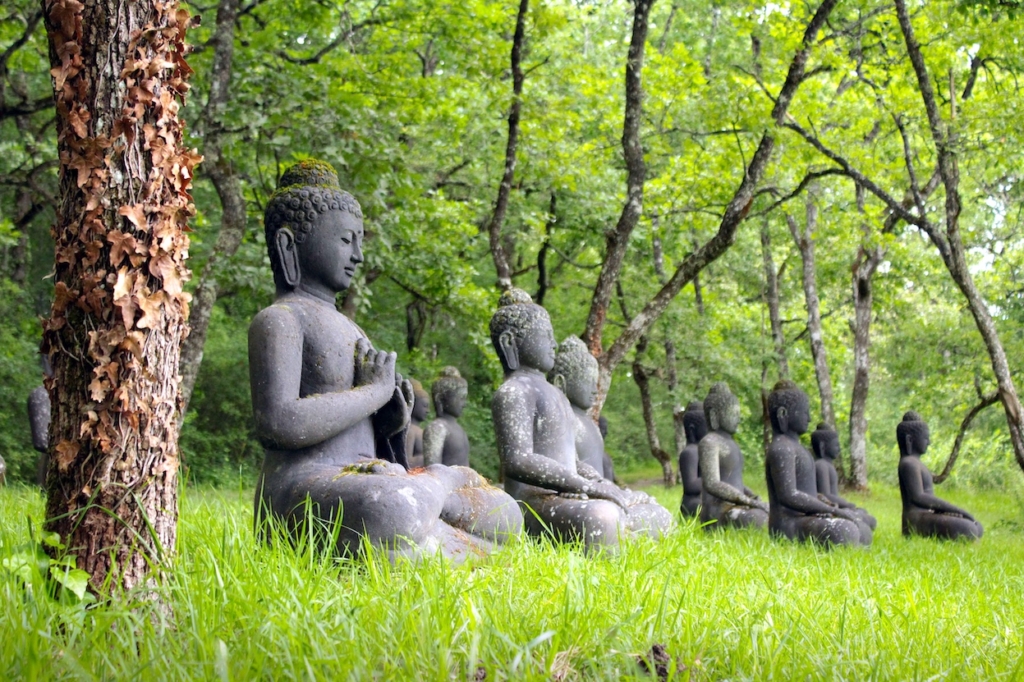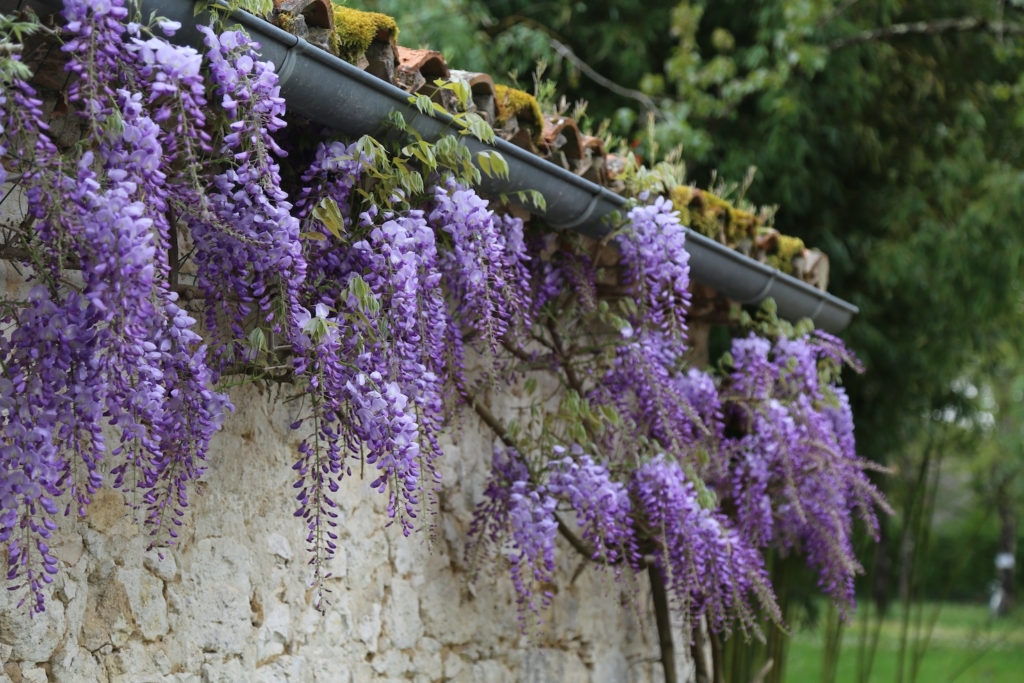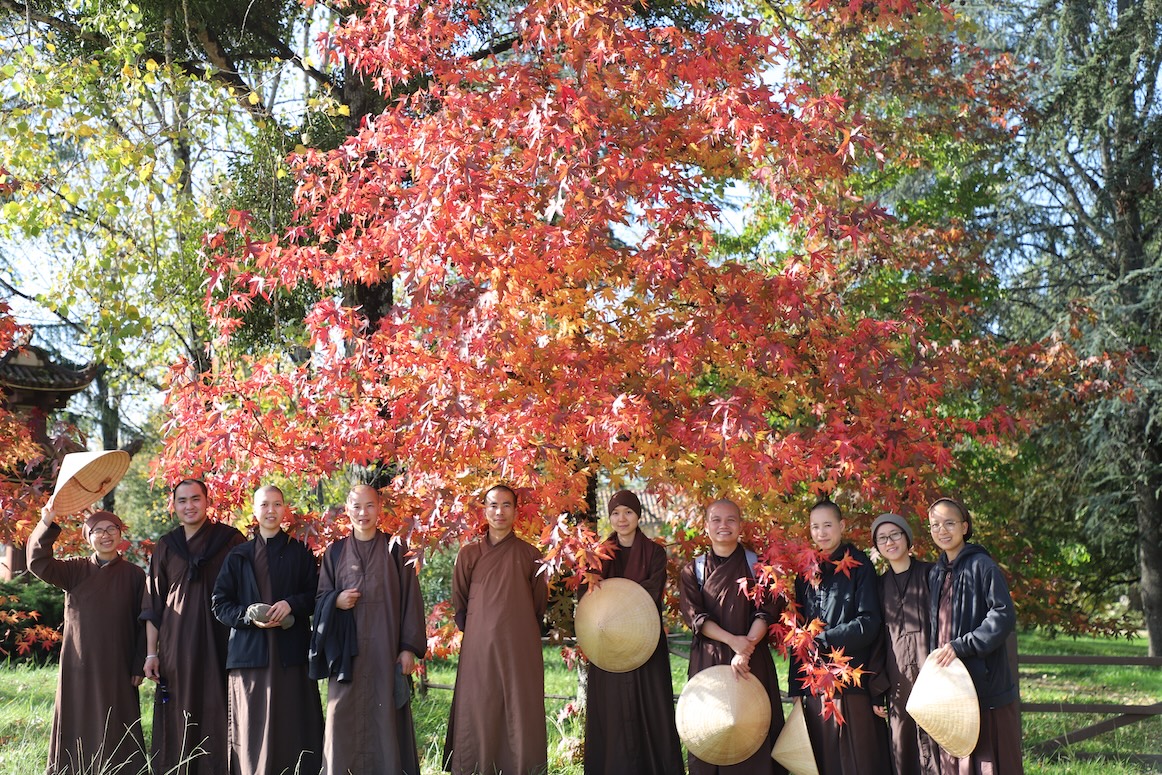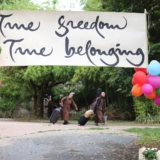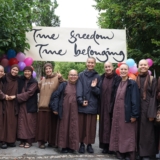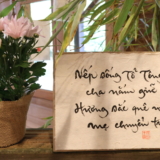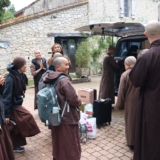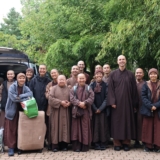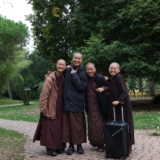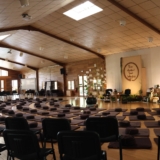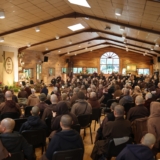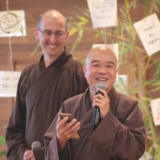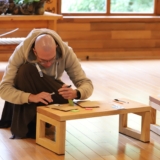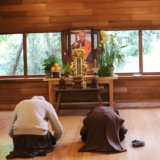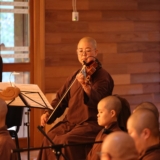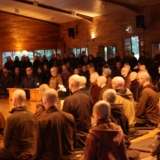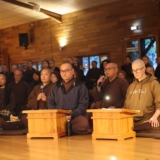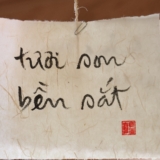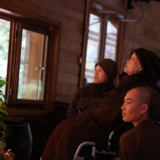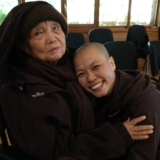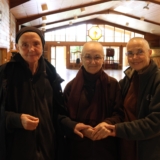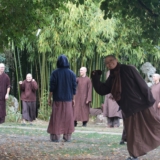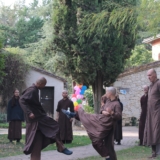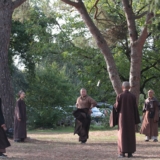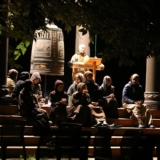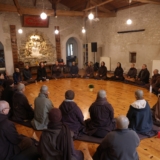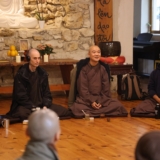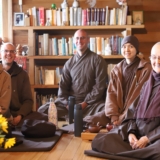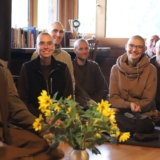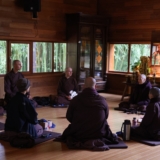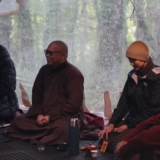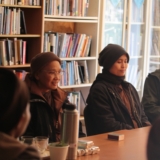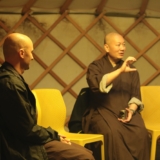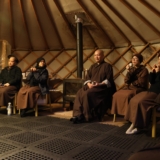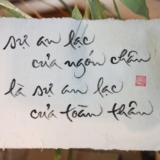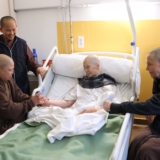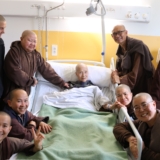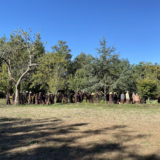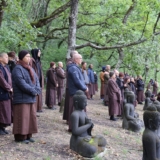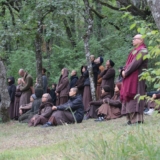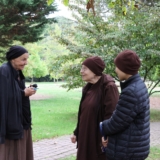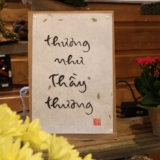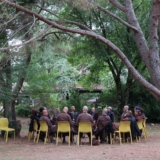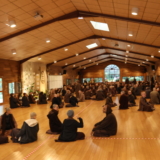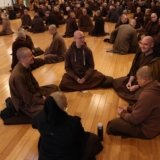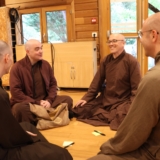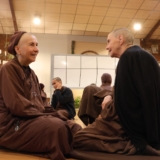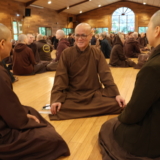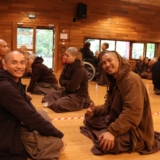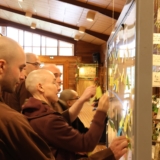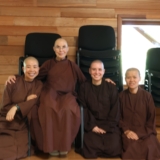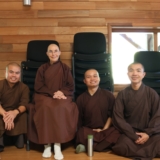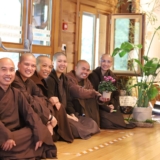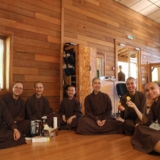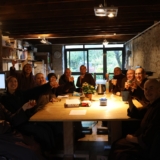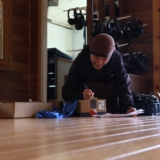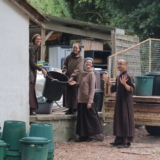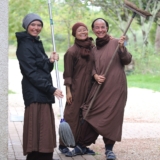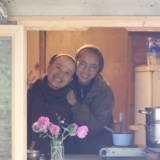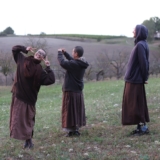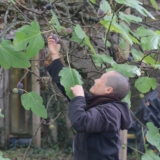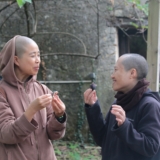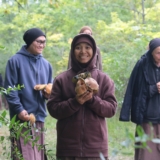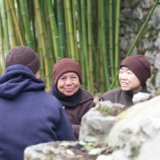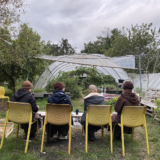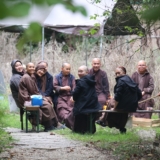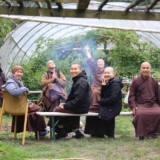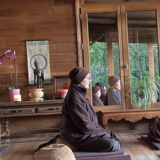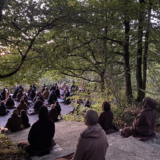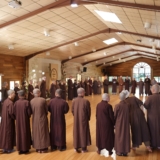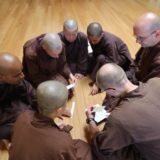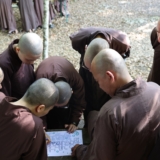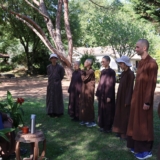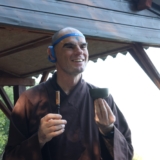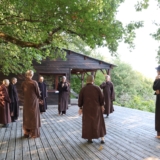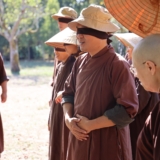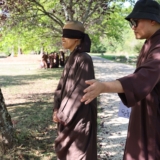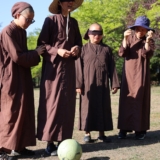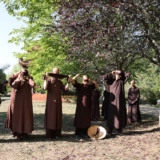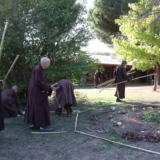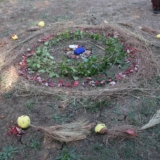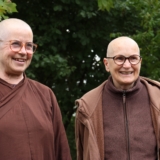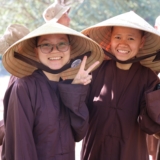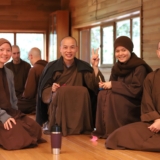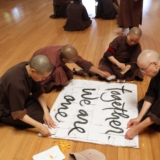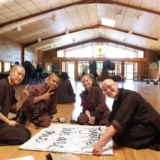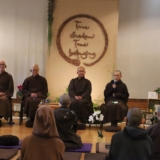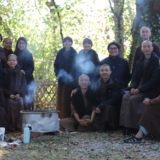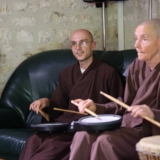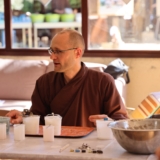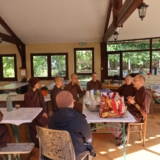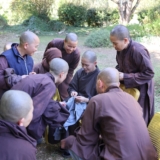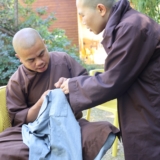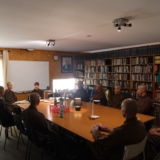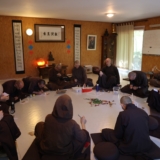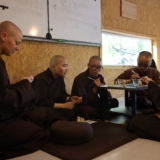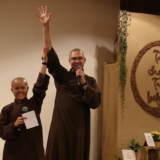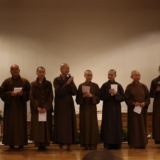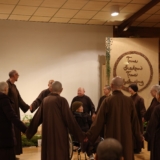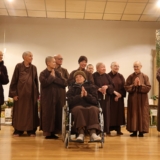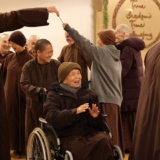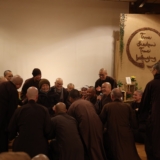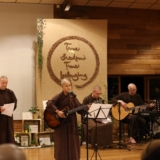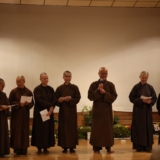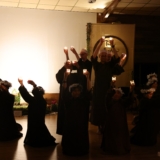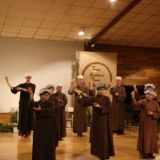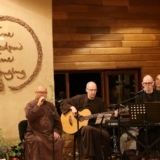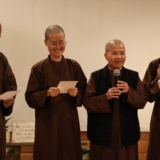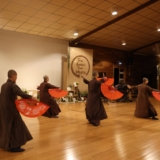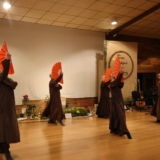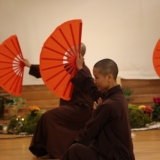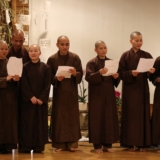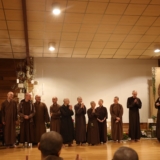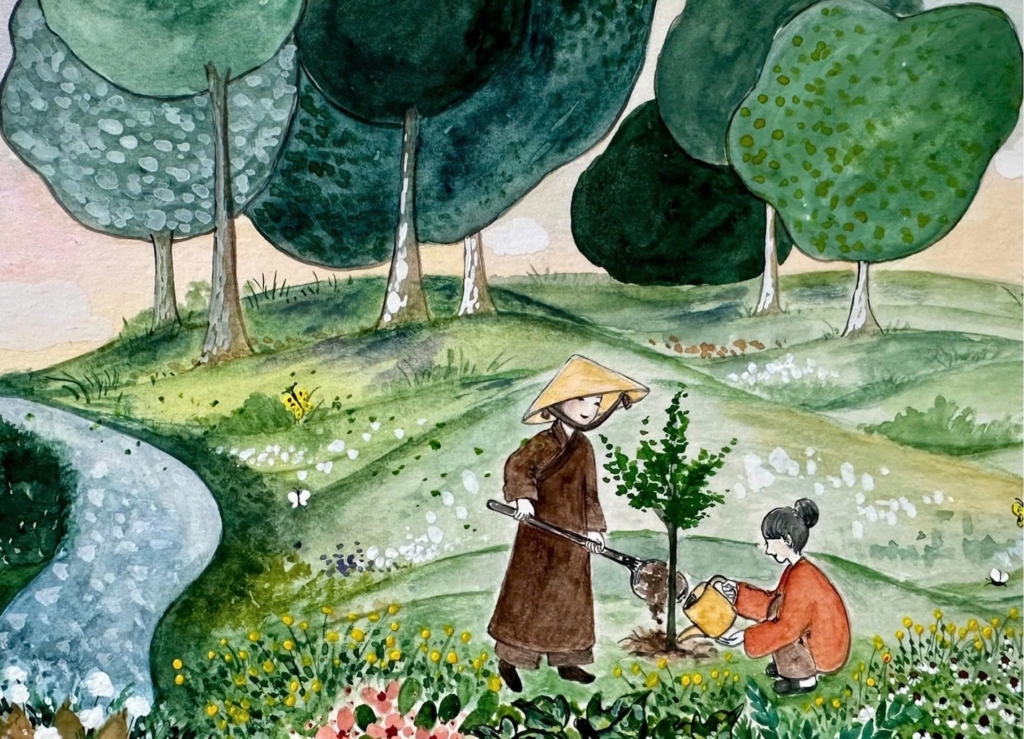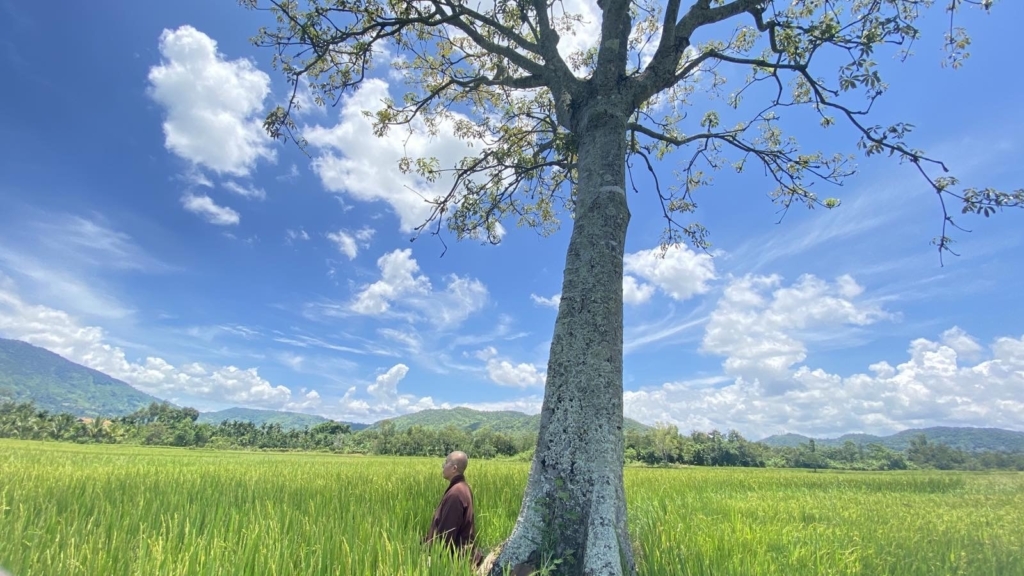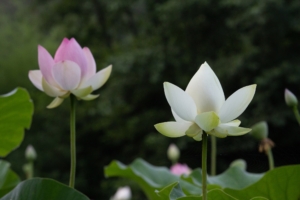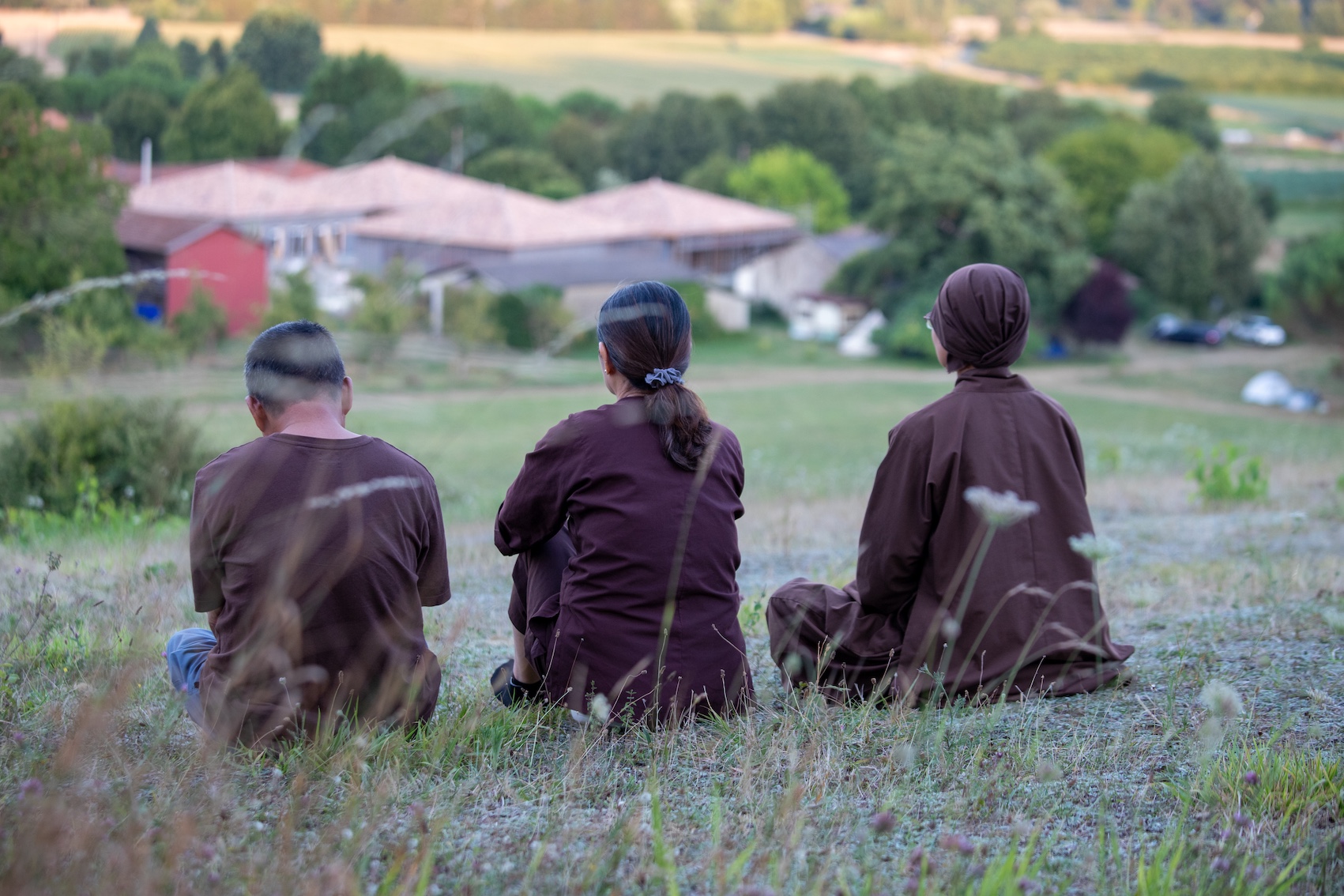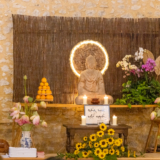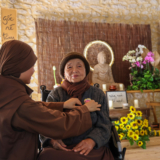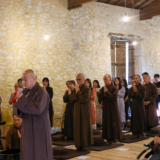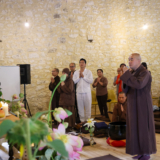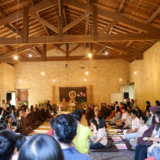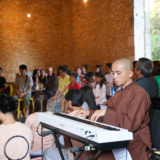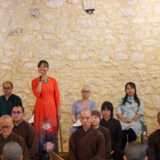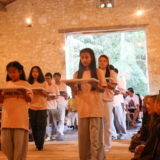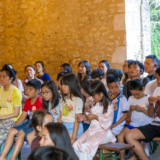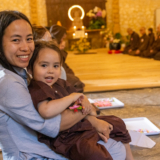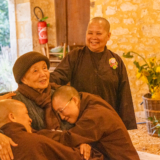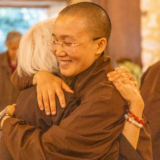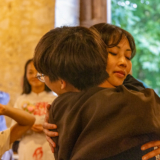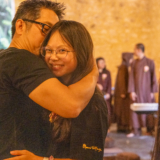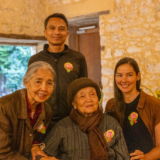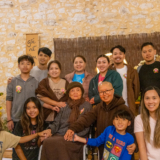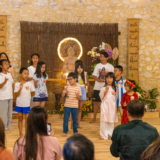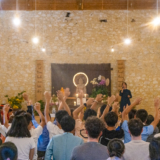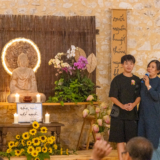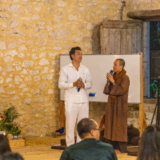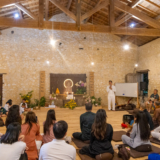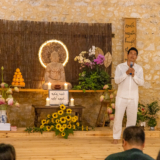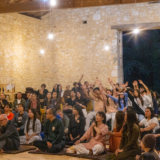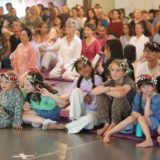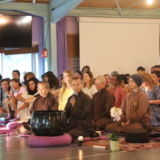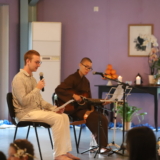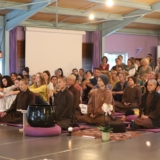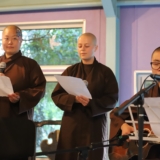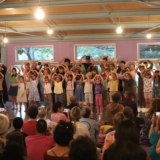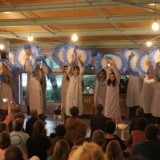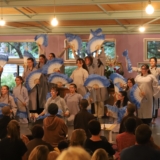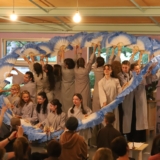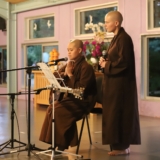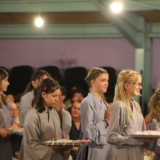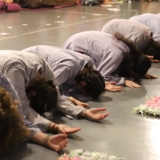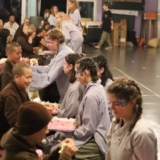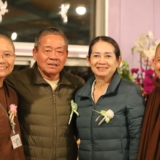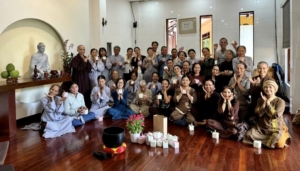Tiến sĩ Hà Vĩnh Thọ – Chân Đại Tuệ là một vị giáo thọ cư sĩ theo truyền thống Làng Mai, được Thiền sư Thích Nhất Hạnh truyền đăng năm 2001. Ông từng làm việc cho Ủy ban Chữ thập đỏ Quốc tế (ICRC), phụ trách chương trình giáo dục và phát triển, trước khi trở thành Giám đốc Chương trình của Trung tâm Hạnh phúc Quốc gia ở Bhutan. Ông là người sáng lập Học viện Eurasia về Hạnh phúc và An sinh, đồng sáng lập Hiệp hội Eurasia (1999 đến nay) – một tổ chức phi chính phủ chuyên triển khai các chương trình giáo dục cho thanh thiếu niên khuyết tật cũng như phát triển các dự án sinh thái ở Việt Nam trong 20 năm qua. Ông có bằng Tiến sĩ Tâm lý học và Giáo dục của Đại học Geneva. Ông đã từng nghiên cứu về ngành trị liệu sức khỏe cơ thể qua giọng nói (Eurythmy and Curative Eurythmy) tại Dornach, Thụy Sĩ và là một nhà diễn thuyết quốc tế, tác giả của nhiều đầu sách, bài viết.
Lời chia buồn từ tăng thân Làng Mai
Anh Chân Đại Tuệ kính quý,
Đại chúng Làng Mai đang cùng thở với anh và cho anh. Trong mỗi hơi thở, ai cũng cảm nhận niềm tri ân sâu sắc đối với tấm lòng phụng sự chân thành và những đóng góp của anh cho đạo Bụt dấn thân – sự nghiệp mà người thầy thương kính của chúng ta, Sư Ông Làng Mai, đã trao truyền lại cho anh.
Chúng tôi đều ý thức rằng “không đi đâu, cũng không cần đến”; công trình tuyệt vời mà anh đã thực hiện ở Bhutan, ở Việt Nam, ở châu Âu và nhiều nơi khác với tư cách là một vị giáo thọ Làng Mai sẽ không bao giờ bị mai một. Công trình ấy là ánh sáng soi đường cho hạnh phúc đích thực trong thế giới đầy những đau thương và xung đột này.
Chúng tôi nguyện sẽ tiếp công trình mà anh đã khơi mở, để giúp “các thầy cô giáo hạnh phúc” cùng nhau làm thay đổi thế giới.
Với lòng biết ơn sâu sắc và cầu nguyện cho anh được tiếp nối trong sự nghiệp mà anh đã để lại cho tất cả chúng tôi.
Sư cô Chân Đức (thay mặt cho Ni Trưởng Chân Không và đại chúng Làng Mai).
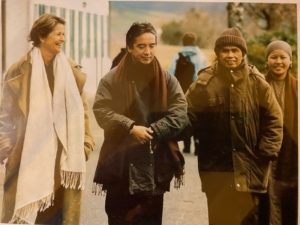
Để tưởng niệm đến anh Chân Đại Tuệ, Ban biên tập Trang nhà Làng Mai xin được đăng lên bài viết “Được gặp Thầy tôi” của anh viết về người Thầy tâm linh kính quý – Thiền sư Thích Nhất Hạnh. Bài viết được BBT chuyển ngữ từ tiếng Anh trích trong Kỷ yếu Đến Đi Thong Dong – Tăng thân Làng Mai biên soạn.
Tưởng niệm người con lỗi lạc của Việt Nam -Thiền sư Thích Nhất Hạnh
Chân Đại Tuệ – Hà Vĩnh Thọ
Tôi được sinh ra từ một người cha Việt Nam và mẹ là người Pháp. Tôi lớn lên và sống qua nhiều quốc gia, nhưng hầu hết là tại châu Âu. Lần đầu tiên tôi về thăm Việt Nam với cha tôi là vào năm 1982, lúc ấy tôi đã 31 tuổi.
Tuy trưởng thành ở nước ngoài, tôi vẫn cảm thấy mối liên kết với quê cha đất tổ, dù có giới hạn là lúc nhỏ tôi đã không được học tiếng Việt và mẹ tôi cũng không nói được tiếng Việt. Chú tôi, ông Hà Văn Lâu, từng là đại sứ Việt Nam tại Pháp và sống ở Paris. Mỗi khi đến hội họp tại Liên Hiệp Quốc ở Geneva, chú thường đến thăm gia đình tôi vì chúng tôi sống ở gần đấy.
Lúc ấy gia đình chúng tôi sống trong một cộng đồng nơi có người chăm sóc cho các trẻ em thiểu năng trí tuệ và chú tôi từng nói rằng chúng ta cũng nên tạo ra một chương trình tương tự để giúp đỡ các trẻ em khuyết tật tại Việt Nam. Trong chuyến viếng thăm Việt Nam lần đầu, tôi đã gặp được nhiều người thân trong gia đình, trong đó có một người chú là nhà điêu khắc Phật giáo nổi tiếng và con trai của chú là một họa sĩ. Hai cha con đều là đệ tử của Thiền sư Thích Nhất Hạnh trong thập niên 1960 và cả hai hỏi tôi rằng đã có cơ hội gặp Thiền sư lúc ấy đang sống tại Pháp chưa. Tôi đã rất xấu hổ khi phải thú nhận rằng tôi chưa từng nghe qua về Người. Vào thời gian đó, Sư Ông chưa được biết đến nhiều tại châu Âu.
Khi về lại châu Âu, tôi đã viết một lá thư gửi Sư Ông để xin phép đến thăm. Đệ tử thân tín của Người là Sư cô Chân Không đã viết một lá thư rất thân thiện mời chúng tôi đến thăm một trung tâm mới mở tại miền Tây Nam nước Pháp tên là Làng Mai. Sư cô cũng gửi tặng quyển Phép lạ của sự tỉnh thức bằng tiếng Anh. Tôi đã đọc quyển sách ấy với tất cả sự hào hứng, nhưng vì một lý do nào đó phải sau nhiều năm thì vợ tôi, Lisi và tôi mới đến thăm được Làng Mai lần đầu vào cuối thập niên 1980.
Khi đến Làng, chúng tôi lập tức được mời dùng trà với Sư Ông và Sư cô Chân Không. Lúc ấy chúng tôi nghĩ rằng sự kiện này chắc thường xảy ra cho mọi người mới đến Làng, là được mời vào cốc của Thiền sư. Thật ra, Sư Ông đã quen biết nhiều người thân của tôi vì gia quyến tôi cũng ở Huế, quê của Sư Ông. Một trong những người chú của tôi và con trai của ông là đệ tử thân tín của Sư Ông và đã từng minh họa một số sách của Sư Ông. Thêm vào đó, Lisi có một người bà con Thuỵ Sĩ mà Sư Ông đã từng gặp trong thập niên 1960 tại Mỹ, ông ấy thuộc về nhóm người Tây phương đầu tiên trở thành tu sĩ theo phái thiền tại thiền viện San Francisco do Thiền sư Suzuki sáng lập ở California. Vì vậy, tuy đến Làng Mai lần đầu nhưng tôi có cảm tưởng như là được về họp mặt thân quyến.
Lần đầu tiên nghe Sư Ông cho pháp thoại, tôi xúc động lắm. Đã hơn một lần tôi nhận ra mình đang khóc trong khi nghe pháp thoại. Không phải vì tôi buồn, mà vì lời dạy của Sư Ông đánh động vào tim tôi một cách quá sâu sắc. Tôi biết, cho đến lúc ấy sự hiểu biết của tôi về lòng Từ bi vẫn còn nông cạn và quá lý thuyết, nhưng khi tiếp xúc trực tiếp với Sư Ông, tôi đã hiểu ra được thực chất sống động của lòng Từ bi kết hợp với năng lượng Trí tuệ rộng lớn cho nên Sư Ông đã có thể diễn bày giáo pháp với vài lời đơn giản mà không đánh mất ý nghĩa thâm sâu.
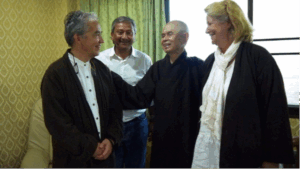
Tôi biết tôi đã gặp được Thầy của mình. Từ đó trở đi, chúng tôi đi khóa tu thường xuyên tại Làng Mai, và cùng với các con, chúng tôi có cơ hội thiết lập được sự liên hệ sâu sắc với Sư Ông. Đối với tôi, đó cũng là một cơ hội mầu nhiệm để kết nối lại với gốc rễ Việt Nam của mình. Sư Ông đã chia sẻ được với thế giới những gì đẹp nhất của văn hóa Việt Nam, và qua Người, rất nhiều người Việt cảm thấy tự hào về gốc rễ của họ và có thể chia sẻ lại cho con cháu họ để nhắc nhở con cháu về nguồn gốc tổ tiên của chúng dù chúng đang sinh sống ở nước ngoài. Những người đệ tử nước ngoài của Sư Ông cũng thiết lập được niềm kính ngưỡng sâu đậm về những nét đẹp và chiều sâu của văn hóa và tâm linh người Việt.
Khi tôi còn nhỏ, trong nhà chúng tôi có bàn thờ tổ tiên nhưng điều đó đã không gợi được ý nghĩa gì nhiều trong tôi. Sau khi viếng thăm Làng Mai và được nghe lời giảng của Sư Ông về tính cách quan trọng của cả hai truyền thống tâm linh và huyết thống, sự thờ cúng tổ tiên đã trở nên rất có ý nghĩa đối với tôi. Cho đến bây giờ tôi vẫn luôn bài trí một bàn thờ tổ tiên trong nhà, và mỗi sáng tôi đều thắp hương, dâng trái cây và trà.
Chúng tôi là một trong những nhóm đệ tử đầu của Sư Ông có được cơ hội về Việt Nam trong thời điểm mà ít người nước ngoài được về. Sư Ông đã rất vui khi nhận được tin tức và hình ảnh từ quê hương và nhất là từ Huế, chùa Tổ Từ Hiếu và từ những đệ tử và bạn của Sư Ông. Khi nhóm chúng tôi trở lại châu Âu, chúng tôi đã tặng Sư Ông một quyển sách với nhiều hình ảnh chúng tôi chụp được những cảnh thân quen mà Sư Ông từng biết đến.
Trong những bài pháp thoại của mình, Sư Ông thường kể những chuyện gần gũi trong dân gian Việt Nam như truyện Kiều, những nhân vật lịch sử như vua Trần Nhân Tông trở thành một nhà sư Phật giáo và các vị đại sư của Việt Nam như Tổ sư Tăng Hội. Qua đó, song song với việc học về đạo Bụt, các đệ tử của Sư Ông cũng được học rất nhiều về văn hóa và lịch sử Việt Nam.
Sư Ông đã khuyến khích chúng tôi thiết lập các dự án giáo dục tại Việt Nam; trước nhất cho các trẻ em khuyết tật và sau đó mở rộng thêm ra. Đây là lý do vợ chồng tôi, với sự trợ giúp của vài người bạn trong ngành giáo dục, đã sáng lập Tổ chức Tài trợ Âu Á (Eurasia Foundation). Và hai vị yểm trợ chúng tôi từ buổi đầu là nhà Đại sứ Hà Văn Lâu và Thiền sư Thích Nhất Hạnh.
Nhìn lại những năm qua với cơ hội được gặp và tiếp nhận giáo pháp từ Sư Ông, trong tôi dâng đầy niềm tri ân sâu sắc. Sư Ông chưa từng đòi hỏi chúng tôi điều gì, để chúng tôi tự do hoàn toàn, nhưng luôn có mặt đó cho chúng tôi. Sư Ông là hiện thân của những điều Người dạy. Tôi đã có nhiều cơ hội gặp Sư Ông thường xuyên trong nhiều bối cảnh khác nhau nhưng Người vẫn vậy, không thay đổi. Sư Ông không đối xử khác khi gặp một người nổi tiếng hoặc quan trọng so với khi gặp một người bình thường đơn giản. Sư Ông đặc biệt thích sự có mặt của các em nhỏ xung quanh và mỗi khi đi thiền hành, Người thường nắm tay các em cùng đi. Sư Ông hiến tặng cho mọi người sự quan tâm đầy từ bi và trọn vẹn như nhau.
Tôi rất ấn tượng cách Sư Ông làm một “Đại sứ” cho Việt Nam. Đối với mọi người trên thế giới, Sư Ông là đại diện đích thực cho văn hóa Việt Nam. Khi tôi chuyển qua Bhutan để làm việc tại Trung tâm Hạnh phúc Quốc gia (Gross National Happiness Centre), tôi muốn thỉnh Sư Ông đến thăm đất nước ấy. Tôi đã thảo luận dự án này với Thủ tướng Bhutan, ông Jigmi.Y Thinley. Ông rất yểm trợ cho dự án này và muốn nó trở thành một chuyến viếng thăm chính thức cấp chính phủ. Tôi cũng có cơ hội tặng quyển Quyền lực đích thực được Thầy ký tên đến Vua đời thứ năm của Bhutan. Đức vua cho tôi biết rằng Ngài đã từng đọc nhiều lần quyển Đường xưa mây trắng: Theo dấu chân Bụt của Sư Ông, thuộc lòng vài đoạn văn trong sách và rất kính quý Sư Ông.
Tiếc thay, chuyến viếng thăm Bhutan của Sư Ông đã không xảy ra. Đầu tiên chúng tôi phải hoãn lại vì có đợt bầu cử toàn quốc, rồi khi Bhutan có thể tổ chức được thì sức khỏe của Thầy lại không cho phép nữa. Tuy vậy, những lời dạy và pháp môn thực tập của Sư Ông đã có những ảnh hưởng quan trọng trong cách chúng tôi hướng dẫn các chương trình Hạnh phúc Quốc gia. Do đó, dù Sư Ông không đến Bhutan bằng hình hài mình, Pháp thân của Sư Ông cũng đã có mặt ở đó và vẫn đang còn có mặt ở đó, vì hầu hết phương pháp chúng tôi điều hành chương trình Hạnh phúc Quốc gia đều liên kết sâu sắc với giáo lý Sư Ông dạy.
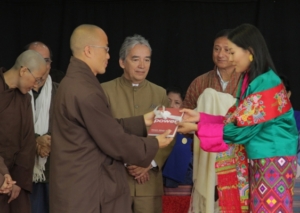
Tôi xin chia sẻ hai giai thoại để diễn tả cách Sư Ông dạy chúng tôi ngoài các bài pháp thoại và những buổi thiền tập chính thức.
Một lần nọ, tôi đang đi bộ với Sư Ông tại Thụy Sĩ. Tôi mới từ Việt Nam trở về và đang kể về chuyến viếng thăm chùa Từ Hiếu. Lúc ấy Sư Ông chưa được về và tôi tin chắc rằng Người sẽ vui khi nghe kể về chùa Tổ và quả đúng như thế; nhưng tôi đoán là tôi đã quá trớn và không thực sự có chánh niệm về nơi mình đang có mặt, ngay nơi ấy và lúc ấy. Vì vậy, một lúc sau, Sư Ông dừng lại và bảo tôi đứng yên. Sư Ông mỉm cười và chỉ xuống mặt đất ngay dưới chân Người và tôi, rồi dạy: “Từ Hiếu đang ở đây và ngay bây giờ”, rồi hai Thầy trò tiếp tục đi.
Một lần khác, khi dùng cơm chiều với Sư Ông cùng Sư cô Chân Không, tôi kể về các dự án giáo dục nhóm chúng tôi đang thực hiện tại Việt Nam. Tôi say mê kể và chắc là không có chánh niệm về những gì mình đang ăn. Nên một lần nữa, Sư Ông mỉm cười, nhẹ nhàng ra dấu tay để dừng tôi lại và hỏi: “Con đang ăn các dự án hay con đang ăn cơm vậy?”. Tôi thấy hơi mắc cỡ, nhưng rất biết ơn được nhắc nhở để thực sự sống trong giờ phút hiện tại. Là một vị Thiền sư đích thực, Sư Ông luôn để tâm giúp chúng ta sống đời sống chánh niệm trong mỗi giây phút của cuộc sống, và Người luôn giúp một cách nhẹ nhàng, với tính hài hước và lòng từ bi.
Khi nghe tin về sự ra đi của Sư Ông, thực sự tôi không cảm thấy buồn, tôi cảm nhận một niềm biết ơn và một tình thương sâu thẳm. Tôi ý thức được việc gặp một bậc thầy lớn trong đời thực sự là một đặc ân. Tôi không cảm nhận là Sư Ông đã ra đi, Sư Ông đang hiện hữu trong những lời dạy và trong vô số đệ tử của Người. Sư Ông có một sức ảnh hưởng to lớn trên hành tinh này. Người đã mang nhiều tuệ giác, tình thương và giá trị luân lý đến cho mọi người khắp nơi trên thế giới. Tinh thần và ý chí của Sư Ông đang có mặt rõ ràng hơn bao giờ hết, và người Việt Nam có thể hãnh diện đã sản sinh ra một người con lỗi lạc, đóng góp và làm rạng danh hồn thiêng nước Việt trong khắp mười phương.
Palézieux, Thụy Sĩ, ngày 27 tháng 01 năm 2022
- Một số chia sẻ của anh Hà Vĩnh Thọ cùng các nhà hoạt động xã hội và môi trường trong khoá tu Giữ Gìn Đất Mẹ vào tháng 06 năm 2023 tại Làng Mai, Pháp.
Câu trả lời là tình thương – phần I
Câu trả lời là tình thương – phần II








